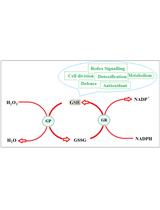- EN - English
- CN - 中文
Cryopreservation Protocol for Chlamydomonas reinhardtii
莱茵衣藻的冷冻保存方案
发布: 2016年11月20日第6卷第22期 DOI: 10.21769/BioProtoc.2024 浏览次数: 9394
评审: Maria SinetovaAgnieszka ZienkiewiczAnonymous reviewer(s)

相关实验方案

极端环境微藻Galdieria phlegrea中还原型和总谷胱甘肽含量的测定
Giovanna Salbitani [...] Simona Carfagna
2017年07月05日 21809 阅读
Abstract
Cryopreservation is commonly used for storing viable cells, tissues, organs or organisms at ultralow temperatures, and usually involves immersion in liquid nitrogen at -196 °C. Here we provide a detailed cryopreservation protocol for C. reinhardtii based on Crutchfield’s work (Crutchfield et al., 1999), with minor changes (Yang and Li, 2016). In this study, we compared the cryoprotection effect of two common cryopreservation agents (CPAs), methanol and DMSO. Furthermore, the two-step cryopreservation process was divided into five stages to study the factors affecting the survival rate at each stage. We found that the use of methanol as the CPA, combined with the cooling process outlined here (cooling from 25 °C to -55 °C at a rate of 1 °C/min), were indispensable for cell survival after cryopreservation. The thawing process described here (thawing at 35 °C for 5 min) was also important for increasing the survival rate.
Background
Nowadays, cryopreservation is used frequently for the storage of transgenic lines or mutation lines of C. reinhardtii, and for experimental needs involving this organism. Morris et al. (1979) discussed the effects of different CPAs in cooling, the relationships between temperature and survival rate with or without the CPAs, and the cooling rate. They found that with the addition of methanol the half-lethal temperature was the lowest of all the CPAs tested (-14.4 °C), while that of DMSO was -4.9 °C (Morris et al., 1979).
Through storage in 7% (v/v) DMSO overnight at room temperature, followed by storage at -70 °C, Johnson and Dutcher (1993) gained the highest viabilities, nearly 10% in C. reinhardtii cultures. However, the survival rate may be restricted in C. reinhardtii cell lines, especially in the cell line CC-125 we used, with viabilities of only 0.34%, although the authors claim was caused by liquid culturing. Nevertheless, this method was time consuming and resulted in low cell viabilities. Crutchfield et al. (1999) reported a two-step cooling procedure for the cryopreservation of C. reinhardtii using 5% methanol as the CPA, which retained relatively high viability (> 40%).
Three different methods for improving survival rate were compared in this study. We followed the protocols mentioned above, and made detailed analyses at each stage of the cryopreservation process. The different effects of methanol and DMSO are also discussed, the results agreeing with the work of previous authors.
Materials and Reagents
- 1.5 ml and 4 ml Eppendorf tubes
- 50 ml flask
- Cryovials (VWR, Nalgene®, catalog number: 5000 )
- Filter membrane (Filter pore size: 0.2-0.3 μm) for tissue culture
- 0.22 μm membrane filters (EMD Millipore, model: SLGV033RB )
- Chlamydomonas reinhardtii CC125 was purchased from the Chlamydomonas Resource Center at the University of Minnesota (http://www.chlamycollection.org/cart/)
- TAP medium (Gorman and Levine, 1965, http://www.chlamycollection.org/methods/media-recipes/tap-and-tris-minimal/)
- Isopropanol, purity ≥ 99.5% (Sangon Biotech, catalog number: A507048 )
- Liquid nitrogen
- Trypan blue (Sigma-Aldrich, catalog number: T6146 )
- Methanol (MeOH) (AR), purity ≥ 99% (Chongqing Chuandong Chemical, catalog number: methanol)
- Dimethyl sulfoxide (DMSO) (Sangon Biotech, catalog number: A503039 )
- Iodine (AR) (Sangon Biotech, catalog number: A500538 )
- Potassium iodide (AR) (Sangon Biotech, catalog number: A100512 )
- Lugol’s iodine solution (see Recipes)
- CPA stock solution (see Recipes)
Equipment
- Thermostatic rocking incubator (Shanghai Shipping, model: SPH-211B )
- Hemocytometer (Qiujing)
- Freezing container (Cryo 1 °C freezing container) (VWR, Nalgene®, model: 5100 )
- Autoclave
- Laminar flow hood
- Microscope (OLYMPUS, model: CX31 )
- Water bath (Amersham Bioscience)
- Portable liquid nitrogen tank
- Centrifuge (Hettich, model: D-78532 Tuttlingen)
Note: This equipment has been discontinued, other types with the same centrifugal force can be used as substitutions. - -80 °C freezer (Thermo Fisher Scientific, model: 8607 )
Software
- Microsoft Office Excel
Procedure
文章信息
版权信息
© 2016 The Authors; exclusive licensee Bio-protocol LLC.
如何引用
Readers should cite both the Bio-protocol article and the original research article where this protocol was used:
- Yang, D. and Li, W. (2016). Cryopreservation Protocol for Chlamydomonas reinhardtii. Bio-protocol 6(22): e2024. DOI: 10.21769/BioProtoc.2024.
- Yang, D. and Li, W. (2016). Methanol-promoted lipid remodelling during cooling sustains cryopreservation survival of Chlamydomonas reinhardtii. PLoS One 11(1): e0146255.
分类
植物科学 > 藻类学 > 生理学
您对这篇实验方法有问题吗?
在此处发布您的问题,我们将邀请本文作者来回答。同时,我们会将您的问题发布到Bio-protocol Exchange,以便寻求社区成员的帮助。
提问指南
+ 问题描述
写下详细的问题描述,包括所有有助于他人回答您问题的信息(例如实验过程、条件和相关图像等)。
Share
Bluesky
X
Copy link











